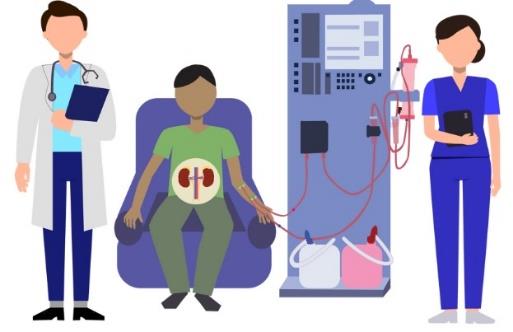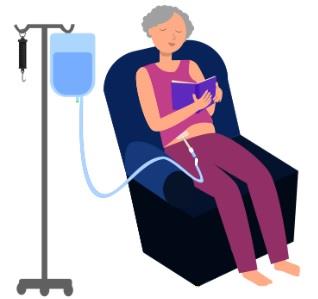Advanced Directive Guide
Download in English. Return to the Advanced Directives Resources page.
This guide explains the options available when creating an advanced directive.
Parts of an advanced directive: [ASL translation]
There are three components of an advanced directive:
- Choosing a health care representative (HCR)
- An HCR will make decisions for you when you cannot make or communicate them.
- You can choose to have no HCR or you can choose one or more HCRs.
- Choosing the health care you want and/or do not want
- This tells your doctors and your HCR what treatment you want or do not want.
- You do not need to complete this part or decide on all the possible scenarios that could happen; instead, your HCR can decide which treatment you will receive in the event that you cannot make or communicate your health care choices.
- Signing the document to make it effective
- In addition to your signature, two witnesses or a notary public must sign.
- If you cannot physically sign the document, you can provide permission for another individual to sign your name on your behalf. (Note: This document is for education purposes and does not constitute legal advice.)
- The law allows you to sign your advanced directive on paper or electronically, and if you are not able to meet in person and in the same physical location with the two witnesses or notary public.
- Giving copies of your signed document to people involved in your health care.
- This includes your HCR(s), doctor, case manager, care provider, and anyone else you want to have a copy.
- If you update your advanced directive, you need to give everyone the updated copy.
Items needed to create an advanced directive [ASL translation]
You will need:
- A government issue, photo ID (if you have one) to prove your identity to the notary public or to the witnesses if they do not know you;
- Your address, phone number, and email address (if you have one); and/or
- Contact information for who you want to serve as your HCR including their name(s), phone number(s), address(es), and email address(es) (if they have one) to ensure your advanced directive is useful in an emergency.
Part 1: Choosing an HCR [ASL translation]
Requirements
An HCR must be 18 years of age or older.
A good health care representative is a person that:
- can communicate with you about your wishes and values;
- you trust to follow your wishes or, if authorized, to act in your best interest;
- is there when you need them;
- will provide you help in the way that you want; and
- will ask doctors questions and speak up about your wishes.
Who decides on my health care if I do not have an HCR?
If you do not pick an HCR, Indiana law provides that your doctors should get consent from the following individuals, in descending order:
- guardian or judicially appointed HCR, if applicable
- spouse
- adult child(ren)
- parent(s)
- adult sibling(s)
- grandparent(s)
- adult grandchild(ren)
- nearest adult relative not already listed
- adult friend with whom you maintained regular contact and is familiar with your activities, health, religious, and moral beliefs
- religious superior, if you are a member of a religious order
However, these people may not know what you want.
What can an HCR do?
An HCR may choose the following:
- doctors, nurses, social workers, and caregivers that will treat you
- hospitals, clinics, nursing homes, and other facilities from which you will receive treatment
- medications, tests, and treatments that you will receive
- who can have your medical information
- what happens to your body and organs upon your death
- whether you die at home or in a hospital
- who can look at your financial information to apply for benefits to pay for your health care
When you die, your HCR can decide:
- to call a religious or spiritual leader (e.g., priest, minister, rabbi, imam)
- whether you receive an autopsy
- to donate your organs
- whether you are buried or cremated
What types of medical treatment can an HCR pick?
Your HCR can decide to start or stop medical treatments, including:
- cardiopulmonary resuscitation
- breathing machine or ventilator
- dialysis
- feeding tube
- blood transfusions
- surgery
- mental health treatment
- medicine
For more information on these treatments, please see Appendix A at the end of this document.
When is an HCR appointed to make decisions for me?
An HCR can make decisions either:
- When a doctor or court has determined you are not able to make your own decision; or
- Upon the signing and completion of your advanced directive. You can have the HCR start making health care decisions for you right away or have them step in only when you have been determined unable to make or communicate your decisions.
However, in either case, if you remain able to choose and communicate you can continue to make your own decisions. You can also end or change your HCR whenever you want by letting the HCR and your doctor know, in writing.
How many HCRs can I have?
You can have multiple HCRs. (Note: If you name 2 or more HCRs and don’t list them in priority order or require joint decision making, each HCR can act individually and independently.) However, you should make sure the person or people you choose as an HCR are comfortable with the responsibility and know your wishes.
Who makes the decision if I have more than one HCR?
That is your decision. You can have a main HCR who makes decisions and a backup HCR if the main HCR is unable or unavailable. You can require your HCRs to agree on decisions. You can specify that whichever HCR your doctor reaches first can make decisions. Sometimes HCRs may not be able to agree on treatment. If there is an emergency and they cannot agree, your doctor may make the final decision.
What if a medical situation comes up that I did not consider?
No one knows the future, and that makes choosing future treatment difficult. Allowing your HCR some flexibility may allow them to address a situation you did not consider. However, you may already know exactly what you want and feel flexibility is not needed. You can decide if your HCR must strictly follow your specifications or if they have flexibility in interpreting your wishes under future circumstances.
Part 2: Making health care decisions [ASL translation]
How should I make medical decisions?
Medical decisions can be difficult for anyone to make. Some people talk with others (like family, friends, and medical providers) before making a decision. Others may make decisions without talking to anyone. Some people trust their doctor’s recommendations, while others do their own research and seek second opinions from other doctors. The method of making medical decisions is as varied as individuals.
Life activities
You may find it helpful to think about what you like to do and with whom. For example, you can decide you want any care that will still allow you to visit your family, go to church, and read. Alternatively, maybe you love food and really enjoy trying different meals. Because your joy comes from tasting different flavors, you may decide that you are willing to try a temporary feeding tube through your nose but do not want a permanent feeding tube in your abdomen.
Wanted medical care
Some people want to live as long as possible no matter what. These individuals want any treatment or device necessary to lengthen their life, and are okay being on a ventilator or dialysis, having a feeding tube or major surgery, and using mobility aids, if the need arises. These people may need daily assistance from medical staff or other caregivers as they adjust to their new circumstances.
Unwanted medical care
Some people do not want certain medical care, for example invasive procedures or rely on medical equipment, even if it means they will die. For these people, comfort or an active lifestyle may be their primary values. For example, some people decide not to receive treatment if it means they will have to use a wheelchair for the rest of their life.
Other people may want to refuse care if they will likely die in the near future. For example, someone with terminal cancer may forgo chemotherapy if their doctor estimated it would only prolong their life by a couple of weeks. These people may value living as fully and comfortably as possible before dying, which may include receiving medication and treatment to manage pain.
What are my options at the end of life?
Some people try anything to live longer. Some people do not want to live longer if they believe the quality of their life will be bad. There are many life support measures doctors can try to keep you alive including:
- cardiopulmonary resuscitation
- breathing machine or ventilator
- dialysis
- feeding tube
- blood transfusions
- surgery
- mental health treatment
- medicine
For more information on these treatments, please see Appendix A at the end of this document.
What happens to my body when I die?
Your HCR or family may be asked about organ donation, an autopsy, funeral wishes, and/or burial wishes after you die. You can tell them what you want.
Organ Donation
If you want to donate your organs, a doctor can take your working organs – such as your heart, lungs, kidney(s), and liver – and give them to another person when you die. The hope is that your organ will keep the person alive. In addition to organs, doctors can use other donated body parts – such as skin, retinas, and bone – to help patients who need them. For example, skin can help burn victims and retina transplants can help some people see again. You can decide before your death whether you want to donate any of your organs or body parts. You can choose to donate any usable organ or body part, list specific organs and/or body parts you wish to donate; or not donate your organs and/or body parts.
Autopsy
An autopsy can help discover why you died. During an autopsy, a doctor examines a dead person’s body on the outside and inside. The doctor also orders tests on the person’s blood. The doctor will use that information to determine the cause of death, which will go on the person’s death certificate.
Some people only want an autopsy if doctors are unsure of why they died. Others may want an autopsy no matter what. Still others never want an autopsy, sometimes due to their religious beliefs. You can generally decide what you want before your death. A court may decide if an autopsy is needed, even if you don't want one.
Funeral or burial wishes
You can decide where your body goes after you die. Options include burial in a cemetery, placement in a vault or mausoleum, and cremation. Even these choices come with options. For example, if you are cremated, you may ask a loved one to keep your ashes or direct that your ashes be scattered somewhere important to you. You can also decide if you want any memorial or funeral services, including whether they be religious in nature, so people who loved you can say goodbye. If you know what you want, these wishes can be communicated before your death
What if I change my mind?
You can always change your mind after creating an advanced directive. You may also want something different today than you will toward the end of your life. If you do change your mind, you must make a new advanced directive and destroy copies of old directives. You must also make sure to give copies of your new advanced directive to your doctor, HCR, and care providers so they know your wishes have changed.
Part 3: Signing your advanced directive [ASL translation]
After you have made your choices, you need to sign the document and have it authenticated. This means having other people sign it who witness that it was actually you who signed. You can have either two witnesses or a public notary sign.
You will need a government issued, photo identification if you are using a public notary. If you do not have government issued photo identification, you can still sign your advanced directive if:
- The witnesses know you personally and are not your health care representative, family or signing on your behalf; or
- Answer questions the witnesses ask about you that show them who you are and that you have capacity to make decisions.
Implementing your advanced directive [ASL translation]
After signing your advanced directive, you will need to:
- Give copies of your advanced directive to your medical providers, HCR, and other members of your care team.
- Make sure you have a copy by either scanning and saving it, taking a picture with your phone, or saving a hard copy in your files.
You will need the name and contact information of your medical providers, HCR, and other members of your care team you want to give the advanced directive to.
Common questions [ASL translation]
What if I have questions about information in this guide?
If you have questions about health care, ask your doctors, nurses, care team, family, or friends. If you have legal questions, ask a lawyer or contact Indiana Disability Rights.
How often should an advanced directive be updated?
Advanced directives do not expire. However, you may want to update your advanced directive if:
- your health changes;
- you want different care than what is written in your advanced directive;
- you want a different or additional HCR; or
- you move to a different state that might have different rules.
Destroy any old advance directives and provide the most updated version to your care team, doctors, and HCR so that your wishes are clear.
Appendix A [ASL translation]
Cardiopulmonary resuscitation (CPR)
CPR involves working on your heart (cardio) or lungs (pulmonary) to help your body work (resuscitation). It can include:
- repeatedly pressing down on your chest to keep blood pumping
- using electrical shocks to get the heart to work
- injecting medicine to help you

Breathing machine or ventilator
Breathing machines pump air into your lungs for you. You may communicate differently while on the machine.

Dialysis
A dialysis machine cleans your blood if your kidneys are not working. The machine moves blood in and out of your body to clean it. A nurse supervises this process and checks your blood pressure while you are at dialysis.

Feeding tube
A feeding tube delivers nutrients to you if you are unable to eat enough. A feeding tube can go through your nose into your stomach (nasogastric tube) or it can be surgically placed through your abdomen into your stomach (g-tube).

Blood transfusions
Blood transfusions put a donor's blood into your body if you do not have enough blood.
Surgery
Surgery is a medical treatment that treats injuries, diseases, and malformations by physical removal, repair, or readjustment of organs and tissues. Surgery often involves cutting into the body. Depending on the surgery, you may be able to go home the day you have surgery (outpatient surgery), or you may need to stay in the hospital (inpatient surgery). Surgery may involve anesthesia which causes a temporary loss of sensation or awareness. Anesthesia and surgery come with risk, particularly for people with underlying conditions. Your doctor should discuss these risks with you if they are recommending surgery.
Mental health treatment
This treatment can include choosing a therapist and psychiatrist; whether you need inpatient care; and whether you need medication and/or other forms of mental health treatment.
Medicine
Medicine can include pills, injections, topical creams, and suppositories.

This Advanced Directive Guide was funded by the Indianapolis Bar Foundation.
Version 2: 23.6.10
